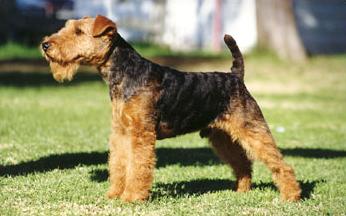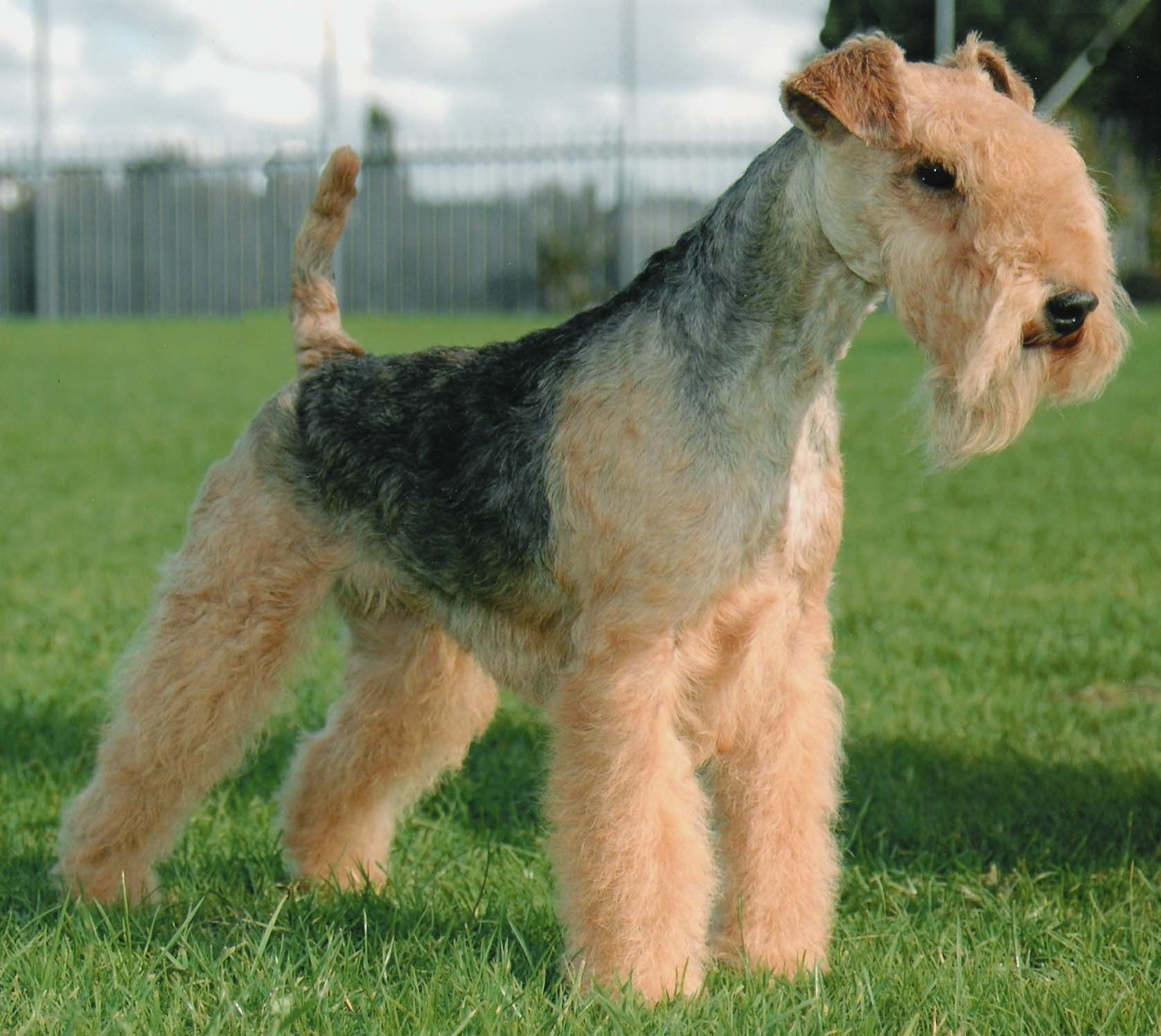
The Breed History
The breed derives its name from the Lake District of England where
early development of the breed took place. This breed is considered
one of the original terrier breeds. The Lakeland shares ancestors with
the Bedlington, Patterdale, and Border Terriers. Perhaps the extinct
Black and Tan Terrier was a progenitor. The first breed standard was
drawn up in 1921. Registration in AKC occurred in 1934.
Breeding for Function
They were raised primarily for fox and otter hunting. They were
renowned for going deep underground. These terriers were also
used for vermin control and for guarding sheep flocks.
Physical Characteristics
Height at Withers: female 13-15" (33-38 cm), male 14-15"
(35.5-38 cm)
Weight: males 17 lb (7.5 kg), females 15 lb (7 kg)
Coat: The double weather resistant coat is harsh and wiry, straight
to slightly wavy in the outer coat layer, and the undercoat is
dense and soft. The brows do not cover the eyes, and beard and
moustache are trimmed for show. Blue, liver, wheaten, red, black,
black and tan, blue and tan, and grizzled are accepted colors. Some
dogs may have a dark saddle.
Longevity: 13-14 years
Points of Conformation: Lakelands possess sturdy square
conformation, moderate muscling and bone, and their expression
is alert. Smallish oval eyes are fairly wide set and colored to match
the dog (hazel, brown, or dark brown), with dark palpebral margins.
Ears are triangular, small and the leather is thick. They fold forward,
with the fold above the topline of the skull. The skull is fairly flat
and broad, muzzle is blocky, and there is a minimal stop. The nose
is black, but may be liver on liver colored dogs. The lips are dark,
neck is long and fine, not throaty, slightly arching, and there are
prominent shoulders. Limbs are straight boned and metacarpals
and metatarsals are short. Dewclaws are usually removed. The
feet are compact, toes well arched, and the pads thick and darkly
pigmented. The topline is level and the back is short, the thorax
is deep and narrow with ribs well sprung, and the abdomen is
moderately tucked up. The high set tail is carried up and curves
slightly forward at the tip. It is commonly docked. The gait is long,
free and smooth.
Recognized Behavior Issues and Traits
Reported traits of this breed include: Courageous at the hunt,
calm temperament, is an independent thinker, mischievous and
playful. Lakelands make a good watchdog. These terriers will fight
with other dogs, and should be socialized early to other pets in the
household. Need close human companionship, plenty of exercise
and mental stimulation to prevent boredom vices, including
digging. Need to be in a fenced area if let off leash. Have moderate
grooming needs.
Normal Physiologic Variations
None reported
Drug Sensitivities
None reported
Inherited Diseases
Hip Dysplasia: Polygenically inherited trait causing degenerative
joint disease and hip arthritis. Too few Lakeland Terriers have been
screened to determine an accurate frequency.
Legg-CalvР№-Perthes Disease: Polygenically inherited aseptic
necrosis of the femoral head, resulting in degenerative joint disease.
Can be unilateral or bilateral, with onset of degeneration usually
between 6-9 months of age. Treat surgically if causing lameness/
discomfort. Frequency and mode of inheritance in the breed has not
been determined.
Patella Luxation: Polygenically inherited laxity of patellar ligaments,
causing luxation, lameness, and later degenerative joint disease.
Treat surgically if causing clinical signs. Too few Lakeland Terriers
have been screened by OFA to determine an accurate frequency.
Elbow Dysplasia: Polygenically inherited trait causing elbow
arthritis. Too few Lakeland Terriers have been screened by OFA to
determine an accurate frequency.
Primary Lens Luxation (PLL): An autosomal recessive gene causes
primary lens luxation. Homozygous affected dogs usually develop
lens luxation between 4-8 years of age. Rarely, heterozygous
carriers can develop lens luxation, but at a later age. Lens luxation
can lead to secondary glaucoma and blindness. A genetic mutation
has been identified, and a genetic test is available.
Disease Predispositions
Persistent Pupillary Membranes: Strands of fetal remnant
connecting; iris to iris, cornea, lens, or involving sheets of tissue. The
later three forms can impair vision, and dogs affected with these
forms should not be bred. Identified in 9.38% of Lakeland Terriers
CERF examined by veterinary ophthalmologists between 2000-2005.
Hypothyroidism: Inherited autoimmune thyroiditis. 7.7% positive
for thyroid auto-antibodies based on testing at Michigan State
University. (Ave. for all breeds is 7.5%).
Cataracts: Intermediate or punctate cataracts. Reported in 7.46%
of Lakeland Terriers presented to veterinary teaching hospitals. CERF
does not recommend breeding any Lakeland Terrier with a cataract.
Glaucoma: Primary, narrow angle glaucoma occurs in the breed.
Can cause secondary lens luxation. Screen with gonioscopy and
tonometry. Frequency and mode of inheritance in the breed has not
been determined.
Other Eye Disorders: Distichiasis, Corneal Dystrophy, and other eye
disorders are reported in the breed, but too few Lakeland Terriers
have been CERF eye examined to determine an accurate frequency.
Cryptorchidism, Microphthalmia, Prognathism, Progressive
Retinal Atrophy, and von Willebrand's Disease are reported.
Isolated Case Studies
Laryngeal Paralysis and Everted Laryngeal Saccules: The
ultrasonographic appearance of laryngeal eversion due to bilateral
laryngeal paralysis is described in a young Lakeland terrier.
Osteochondroma: A Lakeland terrier puppy had progressive
hind limb ataxia associated with pain in the thoracic spine. Plain
radiographs revealed a lesion affecting the dorsal neural arch of
the fourth thoracic vertebra and myelography revealed spinal
cord compression. Surgical excision cured the dog's clinical signs.
Histopathology revealed osteochondromatosis.
Genetic Tests
Tests of Genotype: Direct test for PLL is available from OFA and the
Animal Health Trust.
Tests of Phenotype: Recommend patella evaluation, hip and elbow
radiographs, CERF eye examination, and thyroid profile including
autoantibodies.
Miscellaneous
- Breed name synonyms: Lakeland, Patterdale Terrier (historical)
- Registries: AKC, UKC, CKC, KCGB (Kennel Club of Great Britain),
ANKC (Australian National Kennel Club), NKC (National Kennel Club)
- AKC rank (year 2008): 131 (176 dogs registered)
- Internet resources: The United States Lakeland Terrier Club:
www.uslakelandterrier.org
Lakeland Terrier Club (UK): http://lakelandterrierclub.org.uk/
Photo Gallery of Breed - Lakeland Terrier - Dog Breed








 Animalia Life
Animalia Life